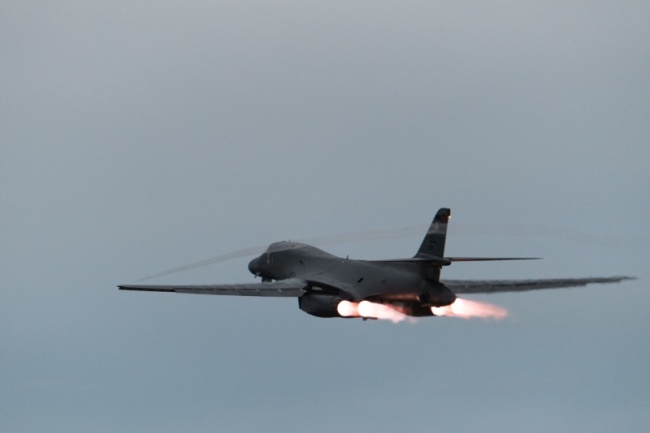The US and South Korean air forces conducted another exercise involving two B-1B bombers in a show of force late Tuesday, while the White House revealed that US President Donald Trump had discussed “a range of options” on North Korea.
According to Seoul’s military, two B-1B bombers of the US Air Force conducted a drill in the East Sea at around 10 p.m. and were later joined by South Korean fighter jets for a joint exercise in the West Sea.
Before entering South Korean airspace, the US strategic bombers had been involved in a joint drill with Japanese air force units.
 |
B-1B Lancer (Yonhap) |
According to the US Pacific Air Forces, an air force command within the US Pacific Command, this is the first time the bombers took part in a nighttime exercise with South Korean and Japanese units.
“The exercise was conducted as part of the South Korea-US agreement on rotational deployment of (US) strategic assets,” a Cheong Wa Dae official said.
In the face of North Korea’s escalating provocations, Seoul and Washington agreed to increase the presence of strategic assets on and around the Korean Peninsula in a display of “overwhelming” military capabilities.
This is the second time the bombers have come to the Korean Peninsula in as many months. The earlier exercise took place in late September, when US bombers flew in international airspace off the east coast. At the time, the Pentagon said the drill involved the bombers flying “farthest north of the Demilitarized Zone any US fighter or bomber aircraft has flown off North Korea’s coast in the 21st century.”
The latest joint South Korea-US drill comes as the White House revealed that Trump had discussed possible options on North Korea with leaders of the US military.
“This morning President Donald J. Trump met with members of his national security team to receive a briefing from Secretary of Defense James Mattis and Chairman of the Joint Chiefs of Staff General Joseph Dunford,” the White House said in a statement released Tuesday.
“The briefing and discussion focused on a range of options to respond to any form of North Korean aggression or, if necessary, to prevent North Korea from threatening the United States and its allies with nuclear weapons.”
North Korea has so far remained quiet, though Seoul and its allies have voiced concerns over the possibility of another provocation in October.
During a meeting between President Moon Jae-in and leaders of South Korean political parties on Sept. 28, National Security Council chief Chung Eui-yong revealed that Seoul has information to believe that Pyongyang may be preparing for a provocation between Oct. 10 and Oct. 18.
Oct. 10 is the anniversary of the North Korean ruling party’s foundation, and the 19th National Congress of the Communist Party of China is scheduled for Oct. 18.
North Korea, however, has yet to carry out provocative actions, choosing instead to highlight celebrations marking the anniversary of the party’s foundation.
Although no military provocation has materialized yet, Pyongyang’s state-run newspaper attacked the US in an editorial published Wednesday.
The editorial accused the US of pushing North Korea toward a nuclear war and said that the country would not stand by in the face of “criminal actions of warmongers.”
By Choi He-suk (
cheesuk@heraldcorp.com)





![[Herald Interview] 'Trump will use tariffs as first line of defense for American manufacturing'](http://res.heraldm.com/phpwas/restmb_idxmake.php?idx=644&simg=/content/image/2024/11/26/20241126050017_0.jpg)


![[Herald Review] 'Gangnam B-Side' combines social realism with masterful suspense, performance](http://res.heraldm.com/phpwas/restmb_idxmake.php?idx=644&simg=/content/image/2024/11/25/20241125050072_0.jpg)